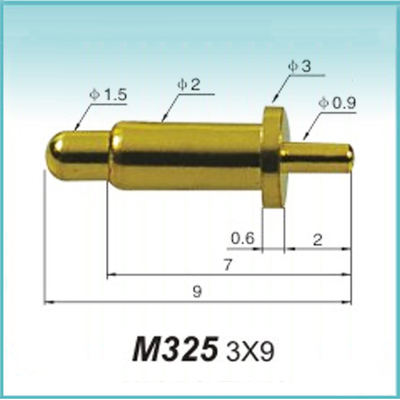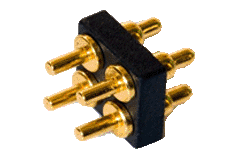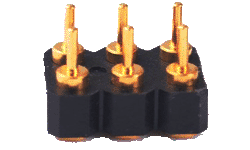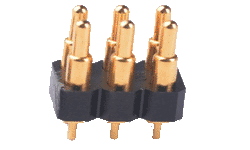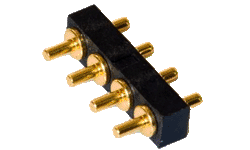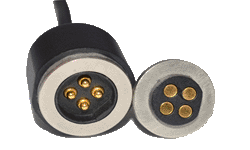2025-3-2 10:32:34
Pogo pins, as precision connector components, are widely used in testing, charging, and data transmission of electronic devices. However, in practical applications,
pogo pins may burn out under excessive voltage, affecting the normal operation of devices. From material properties to structural design, from current-carrying capacity to thermal performance, the reasons why pogo pins burn out may involve multiple aspects. This article provides an in-depth analysis of the reasons behind pogo pins burning out under excessive voltage and offers detailed preventive measures.
1. Material Property Issues
The material selection for pogo pins directly affects their electrical performance and voltage resistance. Common materials include copper alloys and stainless steel, which vary significantly in conductivity and heat resistance. In a smart device testing scenario, improper material selection for pogo pins caused them to burn out under excessive voltage, affecting testing accuracy.
Surface treatment is another critical factor. Pogo pins typically require surface treatments such as gold or nickel plating to enhance conductivity and corrosion resistance. However, improper surface treatment can reduce voltage resistance, affecting their stability under high voltage. In a charging device, improper surface treatment of pogo pins caused them to burn out under excessive voltage.
The thermal expansion coefficient of materials is also a significant factor affecting voltage resistance. Differences in thermal expansion coefficients between materials can generate thermal stress under excessive voltage, impacting the mechanical and electrical performance of pogo pins. In a high-precision testing device, mismatched thermal expansion coefficients caused pogo pins to burn out under excessive voltage.
2. Structural Design Issues
The structural design of pogo pins directly affects their voltage resistance. Poor design can lead to localized electric field concentration, affecting voltage resistance. In a smart device testing scenario, optimizing the structural design of pogo pins resolved the issue of burning out under excessive voltage.
The design of contact points is also an important factor. The shape, size, and position of contact points directly impact voltage resistance. In a charging device, optimizing contact point design improved voltage resistance.
The design of connectors is another critical factor. The structural design of connectors directly affects the voltage resistance of pogo pins. In a high-precision testing device, optimizing connector design resolved the issue of pogo pins burning out under excessive voltage.
3. Current-Carrying Capacity Issues
Current-carrying capacity is a significant factor affecting the voltage resistance of pogo pins. Insufficient current-carrying capacity can cause pogo pins to burn out under excessive voltage. In an automated production line, improving current-carrying capacity resolved the issue of pogo pins burning out under excessive voltage.
Contact resistance is another critical factor. Excessive contact resistance can cause localized overheating, affecting voltage resistance. In an electronic device testing scenario, reducing contact resistance improved voltage resistance.
The cleanliness of contact surfaces is also an important factor. Contaminants such as dust and oil can increase contact resistance, affecting voltage resistance. In a high-precision testing device, improving the cleanliness of contact surfaces resolved the issue of pogo pins burning out under excessive voltage.
4. Thermal Performance Issues
Thermal performance is a significant factor affecting the voltage resistance of pogo pins. Poor thermal performance can cause pogo pins to overheat under excessive voltage, affecting their mechanical and electrical performance. In a smart device testing scenario, optimizing thermal design resolved the issue of pogo pins burning out under excessive voltage.
The thermal conductivity of materials is another critical factor. Materials with low thermal conductivity can lead to poor thermal performance, affecting voltage resistance. In a charging device, selecting materials with high thermal conductivity improved voltage resistance.
The design of thermal structures is also an important factor. Proper thermal structure design can enhance the thermal performance of pogo pins, improving their voltage resistance. In a high-precision testing device, optimizing thermal structure design resolved the issue of pogo pins burning out under excessive voltage.
5. Preventive Measures and Optimization
Material selection and optimization are the first steps. Choosing suitable pogo pin materials ensures conductivity and heat resistance. In a smart device testing scenario, optimizing material selection resolved the issue of burning out under excessive voltage.
Structural design optimization is the second step. Optimizing the structural design of pogo pins, contact point design, and connector design improves voltage resistance. In a charging device, design optimization improved voltage resistance.
Current-carrying capacity optimization is the third step. Improving current-carrying capacity, reducing contact resistance, and enhancing the cleanliness of contact surfaces improve voltage resistance. In an automated production line, current-carrying capacity optimization resolved the issue of pogo pins burning out under excessive voltage.
Thermal performance optimization is the fourth step. Optimizing thermal design, selecting materials with high thermal conductivity, and improving thermal structure design enhance voltage resistance. In a high-precision testing device, thermal performance
